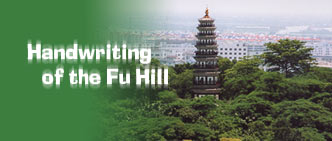 Study Tower is one of the 10 Scenic Spots in Zhongshan and it had been enlisted as one of the 8 Scenic Spots of Xiangshan in the Reign of Kangxi of the Qing Dynasty. It was built on a hilltop in Zhongshan Park and that makes it more typical of its local touch.
Study Tower is one of the 10 Scenic Spots in Zhongshan and it had been enlisted as one of the 8 Scenic Spots of Xiangshan in the Reign of Kangxi of the Qing Dynasty. It was built on a hilltop in Zhongshan Park and that makes it more typical of its local touch.
If you want to enjoy the beauty of this tower, you have to scramble the 302 steps (Taking the road surrounding the hillsides to the back door is another way). Going up the steps dates back in history.
In 1946, the overseas Chinese, whose hometown is Zhongshan, raised funds to built this park and named it Zhongshan Park revolving around the Yandun Mountain. The two arches at the front and back gates of the park were all built after the liberation. The four Chinese characters meaning “Zhongshan Park” were written by Mr. Ou Chu, a Zhongshan born revolutionary who led the revolution of the Five Osmanthus Hill area and became the secretary of Guangzhou City later.
The Yandun Hill is also called the Fu Hill or the Shiqi Hill. The tale tells us there was an isolated island, and the fishermen around use to be trapped by the bad weather when fishing out before the sunrise and after the sunset. In order to build something to direct them especially at night for their return, they decided to make a signal fire at the hilltop. This hill was hence called Yandun Hill (Hill of Smoke Stump).
Another legend says there was a signal fire beacon for defending the invasion of enemies, and that may be the name’s source of this hill. The park covers about 90 thousand square meters, built with its back against a hill. At the upper end of the 128 stone steps is the hill-surrounding road reaching into a world of shady trees. If you think that it is too tiring to take the steps, you may prefer the hill-surrounding road on foot that spirals to the top. The road and paths here are palisaded with green bamboo, high mallows, towering phoenix trees, banyans and other evergreen trees. The verdant park is dotted by fresh lawns, alcoves, rain shelters, corridors and stone chairs, a tranquil world under a great colorful canopy. In the beginning of a summer, there is the chirping of cicadas, reminding you the famous verse of “Cicada chirping sets off the tranquility of the woods/Bird singing defines what peacefulness is in the mountains.” This is a real summer resort and there are so many people that come here for their morning exercises and walks.
There is the Zhongshan Pavilion of Memory in the park built with the donations by overseas Chinese in the form of 4 sides and 8 pillars, oblong shaped. Between the joints of the upper parts of the pillars and the green glazed tiles are the Chinese characters of “Zhongshan.” In the front of the pavilion are the characters of “Zhongshan Pavilion of Memory” while in the back is a plaque with inscriptions “The World Is for the Public” by Sun Yat-sen. Having witnessed decades of elements, the pavilion stands high for the modern people to relive the great achievements of Sun Yat-sen. Close to the top of the hill, facing you are the 8 Chinese characters “Monument of the Iron City/Landmark of the Country of Lakes and Rivers,” Zhongshan people’s applause of the Study Tower.
Study Tower was built in the 36th year of the Wanli Reign of the Ming Dynasty (1608), more than 300 years back. It is 7-story engraved brick tower with 7 gables and it is said the tower was built to relieve Xiangshan County of the poverty then. It is 24.5 meters high (over 7 zhang in the Chinese measure). The immensity of the tower body does not mean that it lacks its elegant mien with its stone steps spiraling up to the top. Looking out against the rails on the top, your eyes are greeted by the scenes of the whole city and its surroundings, embodying a famous Chinese verse, “A higher stand commands a better view afar.” The tower has witnessed ups and downs since its building. In 1983, the Zhongshan Municipality appropriated special funds to renovate the body and coat it with light decorations. When night falls, the tower shines like a magic tower and it can be discerned from over 10 kilometers from the city.
Each Double Ninth Festival, the old and the young come here to go climbing the hill, and it constitutes a spectacular activity. People go round the tower inside to see the meaning of going up high in life.